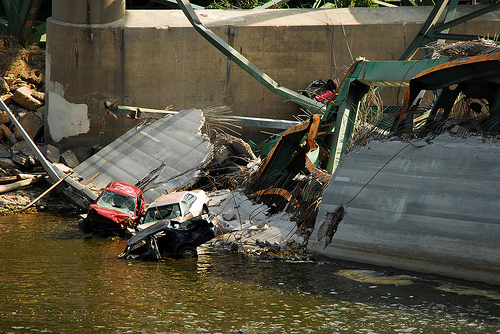A “cut and cap” solution to Austin I-35 highway may better connect Texas
You’ve no doubt already read — on this blog and likely elsewhere — about the decaying, often disastrous state that our country’s highways are currently in, from Oklahoma to Michigan, Florida to California. There is broad consensus among government, engineers, and the driving public about the state of the roads, but with limited budgets and conflicting opinions, there isn’t similar accord over potential solutions.
In a recent post for CNU (the Congress for New Urbanism) and its Highways to Boulevards initiative, LeRoy Taylor, a CNU project assistant and Masters candidate, outlines the state’s three potential solutions for the deterioration and modernization problems facing a particular stretch of Interstate 35, running through Austin, Texas. I-35, the fourth most congested highway in the country, runs from Laredo, Texas, which is near the Mexico border, northwards to Duluth, Minnesota. It’s known as the Interregional Highway in Austin, Texas, where an expansion resulted in elevated express lanes framing the original highway. The I-35 is also rife with 50-plus year-old bridges in disrepair.

Austin’s I-35 is in need of either elevated or depressed streets – and either way, it ain’t going to be cheap. From Dr. Colleen Morgan.
The three options include: 1) elevating surface streets; 2) depressing the main lanes below street level; and 3) constructing a complete cap over the depressed lanes. The majority of residents, argues Taylor, are opposed to option 1, on the ground that it “fix[es] the problem by making it bigger,” and would require millions of dollars in funding. Others are opposed to the second option, which has been suggested previously, because it is a shorter-term solution. The third alternative, and a controversial one, is known as a “cut and cap” plan. It expands on option 2, and involves building a permanent cap — also known as a boulevard — over the depressed lanes. Taylor, in favor of option 3, suggests that the fix would provide new jobs, an increased quality of life for residents, and a connection between the East and West areas of the city. Writes Taylor, “Over 25 years this idea could create about 48,000 jobs, yield $3.2 billion in new tax base, and generate an estimated $1 billion in recurring, new property tax revenue. How’s that for a long-term benefit?”
Urban developer, architect and author Sinclair Black is leading the charge for the “cut and cap” proposal echoed by Taylor. “People need to know that they need to choose between a perpetuation of the barrier that we have in the building of more elevated [I-35] freeway lanes or to take a deep breath and solve the problem once and for all and forever,” Black told the Community Impact Newspaper back in April.

I-35 was already home to the Minnesota bridge collapse of 2007. Could more problems be in store? From Marion Doss.
DANA, the Downtown Austin Neighborhood Association, summarized Black’s “cut and cap” plan: replace the existing highway with a “four lane, landscaped, pedestrian- and cyclist-friendly boulevard… recaptur[ing] approximately 30 acres of land above the interstate to productive, tax-producing use. By rearranging the horizontal and vertical space now taken up by the highway, this project would not only create more capacity for vehicles on I-35, but also weave together the vibrancy of downtown with the rich culture of East Austin.”
In an age of short-term fixes, temporary solutions, and prolonged budget woes, however, the plan has a still greater benefit. Said Black: “This is building a solution for the next 200 years instead of the next 50.”
Category: Construction, Infrastructure, Resources














